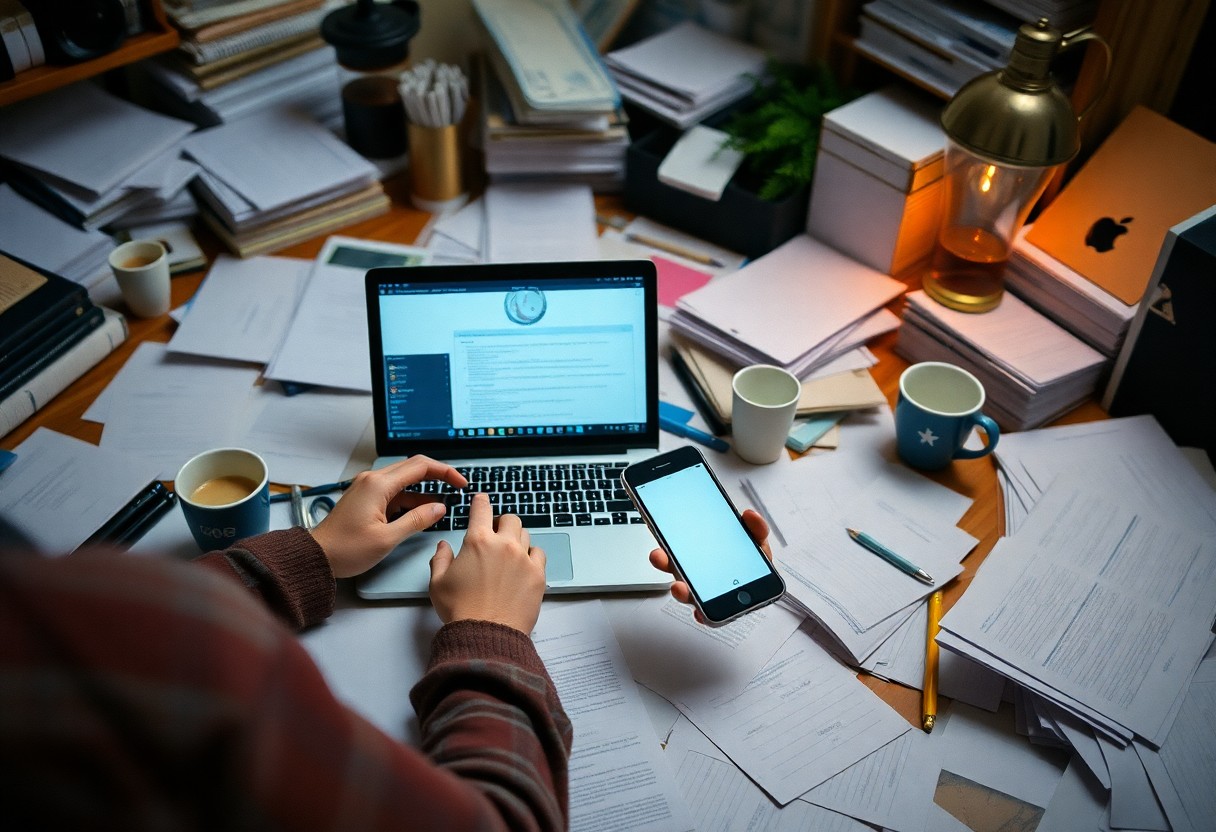You may think that multitasking makes you more productive, but research shows that it can actually decrease efficiency and lead to mistakes. When you shift your focus from one task to another, your brain struggles to adapt, often resulting in longer completion times and reduced quality. This blog post will uncover the realities of multitasking, helping you understand its effects on your performance and suggesting effective strategies for managing your time and tasks in a way that maximizes your focus and productivity.
Key Takeaways:
- Multitasking often leads to decreased productivity and increased errors due to the cognitive load it imposes on the brain.
- Focusing on one task at a time enhances efficiency and the quality of work, allowing for deeper engagement and better outcomes.
- Implementing structured work periods with breaks can improve concentration, helping to combat the temptation to multitask.
The Science of Attention: Why Multitasking is a Myth
Research consistently shows that multitasking is not an effective strategy for completing tasks. Your brain can only focus on one cognitive task at a time, leading to a significant decrease in overall productivity. The human mind is wired to focus on one activity before switching, and attempting to juggle multiple tasks often results in what scientists describe as cognitive overload. This overload not only hampers your performance but can also jeopardize the quality of your work.
Cognitive Limitations: The Brain’s Capacity for Focus
Your brain has inherent limitations when it comes to sustaining attention. Neuroscientific studies reveal that you can only focus on about four to five discrete pieces of information in working memory at a time. Attempting to manage multiple tasks simultaneously pushes the brain’s limits, resulting in reduced efficiency and increased likelihood of mistakes. This cognitive bottleneck underscores why focusing on a single task leads to better outcomes.
The Role of Context Switching in Productivity Loss
A significant contributor to productivity loss is context switching, the act of shifting your focus from one task to another. Every time you switch contexts, your brain needs time to reorient itself, often taking up to 20 minutes to regain your optimal focus. This constant toggling not only consumes precious mental energy but also disrupts your flow, diminishing the quality of your output and increasing fatigue.
The impact of context switching on your productivity is profound and can dramatically affect your workflow. When you frequently switch tasks, you invite inefficiencies into your routine. Studies show that the average office worker switches tasks roughly once every 3 minutes, leading to substantial time wasted in refocusing. As a result, your work may suffer from lack of depth, and the final products are typically less polished than if you had dedicated your attention to a single task. Streamlining your focus can enhance both productivity and creative output, demonstrating the importance of prioritizing cognitive clarity over scattered efforts.
The Cost of Distraction: How Multitasking Impacts Performance
Multitasking may seem like a savvy way to maximize productivity, yet it comes at a significant cost. Research has shown that shifting your focus between tasks consumes valuable mental resources and leads to a decline in overall performance. In fact, studies indicate that multitasking can reduce productivity by as much as 40%, making you less efficient and more prone to mistakes. The illusion of getting more done can be misleading, as constant distraction hampers your ability to concentrate and produce high-quality work.
Decreased Efficiency: The Hidden Time Sink
The reality of multitasking is that it often leads to a state of decreased efficiency that you might not even notice. When you divide your attention between multiple tasks, you unwittingly spend additional time on transitions, resulting in a drawn-out work process. For example, if you switch between emails and project reports, each transition consumes cognitive resources and time, ultimately making the workload seem heavier than if you tackled one task at a time.
Quality vs. Quantity: The Trade-off in Task Accomplishment
Engaging in multiple tasks simultaneously often forces you to choose between quality and quantity. While you might check off several items from your to-do list, the quality of your output inevitably suffers. Studies have pointed out that people who multitask tend to produce work that is poorer in quality—while they may complete tasks rapidly, the attention to detail falters, leading to errors, rework, and dissatisfaction.
When you juggle multiple responsibilities, the immediate satisfaction of ticking boxes off your list can be deceptive. You might finish ten tasks, but closer examination will show that they lack depth and thoroughness. In many cases, the energy you invest in managing several tasks simultaneously results in a subpar product. For instance, an employee rushing to send multiple emails may overlook crucial details, leading to misunderstandings or costly mistakes. This trade-off between quality and quantity not only hampers your performance but can also impact your overall reputation in the workplace. Prioritizing high-quality work, even at the expense of fewer completed tasks, ultimately yields better long-term results.

Debunking the Multitasking Myth: Insights from Research
You might find it surprising that an abundance of research clearly illustrates the drawbacks of multitasking. Studies reveal that engaging in multiple tasks simultaneously can lead to a decrease in overall productivity, a phenomenon often referred to as the “switching cost.” Each time you shift your focus, there’s a delay in processing the information, which can reduce efficiency by as much as 40%, according to various cognitive studies. This illustrates that what feels like a time-saver often results in more time spent on tasks.
Studies That Challenge Multitasking Success
Many prominent studies challenge the idea that multitasking can lead to successful outcomes. For instance, research published in the journal *Psychological Science* found that individuals who attempted to juggle tasks performed worse on cognitive tests compared to those who focused on one task at a time. During a driving experiment, drivers distracted by phone calls were less able to react to sudden changes in their environment, highlighting the hazards linked to divided attention.
The Neuroscience Behind Sequential Tasking
The brain’s architecture is inherently designed for sequential tasking rather than multitasking. Neuroscience reveals that the prefrontal cortex, responsible for complex thought, has limited processing power, which is significantly impaired when you switch between tasks. Engaging in multiple tasks forces your brain to work harder, leading to quicker mental fatigue and reduced overall performance. Studies show that it can take up to 25 minutes to regain full concentration after a distraction, resulting in less effective work.
Strategies for Single-Tasking: Maximizing Your Focus
Establishing effective single-tasking strategies allows you to maximize focus and efficiency. Prioritize tasks by creating a to-do list, identifying the most important activities, and scheduling dedicated time blocks for each. Use techniques like the Pomodoro Technique, which involves working diligently for 25 minutes followed by a 5-minute break. These strategies help you develop a rhythm, increase motivation, and keep distractions at bay, making your work sessions more productive.
Techniques for Cultivating Deep Work
Engaging in deep work requires intentional effort and specific techniques. Start by identifying your peak productivity hours, and reserve them for high-concentration tasks. Minimize interruptions through time-blocking, where you set aside uninterrupted periods dedicated solely to one task. Creating a physical space conducive to concentration—such as a clutter-free desk or a quiet room—also enhances your focus, allowing you to tap into your creative potential.
Tools to Reduce Distraction and Enhance Concentration
Numerous tools can assist you in reducing distractions and enhancing concentration. Applications like Freedom and Cold Turkey block distracting websites, ensuring you stay focused during work sessions. Noise-canceling headphones can drown out background disturbances, while productivity timers help maintain accountability. Additionally, project management tools like Trello or Asana can streamline task organization, providing clarity on your workload and allowing you to maintain concentrated efforts on individual tasks.
Using tools effectively can transform your working environment. For instance, the use of an app like Focus@Will offers specially curated music tracks designed to enhance your concentration. Setting up your digital workspace with browser extensions like StayFocusd to limit social media time can keep you engaged in your work. By integrating these tools into your routine, you foster an ecosystem that promotes single-tasking, leading to heightened productivity and reduced stress as you reclaim control over your focus.
Real-World Applications: Shifting the Workplace Culture
Embracing a culture that prioritizes focused work over the myth of multitasking requires a systematic shift in workplace norms. Companies are adopting policies that encourage uninterrupted work periods, enabling employees to dive deeper into tasks without the constant fear of distractions. Initiatives such as “no meeting days,” dedicated time blocks for focused projects, and fostering an environment that values quality over quantity are reshaping how you approach productivity.
How Companies are Embracing Single-Tasking
Organizations are increasingly instituting practices that promote single-tasking as a means to enhance productivity. For example, companies like Google and Asana implement “focus hours,” during which employees can concentrate on critical assignments without interruptions. This approach not only enhances productivity but also cultivates a culture that recognizes the power of undivided attention.
The Long-Term Benefits of Focused Work Environments
Investing in focused work environments can lead to significant improvements in employee satisfaction and overall output. Research shows that teams dedicated to single-tasking achieve greater task completion rates, with estimates indicating a potential boost of up to 40% in productivity. As you cultivate such an environment, employees become more engaged, leading to lower turnover rates and enhanced team collaboration.
The long-term benefits of fostering focused work environments extend beyond immediate productivity gains. With a dedicated approach to single-tasking, your organization can see improvements in mental well-being, reduced stress levels, and enhanced creativity. Employees who feel they can dedicate their attention to one task report increased job satisfaction and a greater sense of accomplishment. Not only does this approach lead to better results, but it also fosters a workplace culture where quality work is valued, ultimately reinforcing your company’s reputation and boosting overall performance.
Final Words
On the whole, you should recognize that multitasking is more myth than reality. Instead of attempting to juggle multiple tasks at once, focus on one thing at a time to enhance your productivity and quality of work. By doing so, you will not only improve your efficiency but also reduce stress and increase satisfaction in your daily activities. Embrace single-tasking as a valuable strategy for achieving your goals, and you’ll find your effectiveness in both personal and professional realms will soar.
FAQ
Q: What is ‘WorkWell – The Myth of Multitasking’ about?
A: ‘WorkWell – The Myth of Multitasking’ explores the concept of multitasking and its impact on productivity and mental health. The program contends that multitasking is often a misconception that leads to decreased efficiency, as the brain struggles to switch between tasks, resulting in increased stress and diminished focus. Through various strategies, it encourages individuals to concentrate on single tasks to enhance overall performance and satisfaction in their work life.
Q: How does multitasking affect our productivity levels?
A: Research shared in ‘WorkWell – The Myth of Multitasking’ indicates that multitasking can lead to a decline in productivity. When individuals attempt to juggle multiple tasks simultaneously, their brain experiences cognitive overload, causing delays in task completion and an increased error rate. This program offers insights into the benefits of focusing on one task at a time, thereby improving both output quality and speed, leading to a more streamlined workflow.
Q: What strategies does ‘WorkWell – The Myth of Multitasking’ suggest for improving focus?
A: The program provides several actionable strategies aimed at enhancing concentration and productivity. Some of these include setting specific time blocks for single-tasking, utilizing tools like the Pomodoro Technique to manage time effectively, minimizing distractions by creating a dedicated workspace, and periodically reviewing progress to stay aligned with goals. Implementing these strategies can help individuals develop habits that prioritize focus, ultimately leading to increased efficiency and job satisfaction.

Leave a Reply